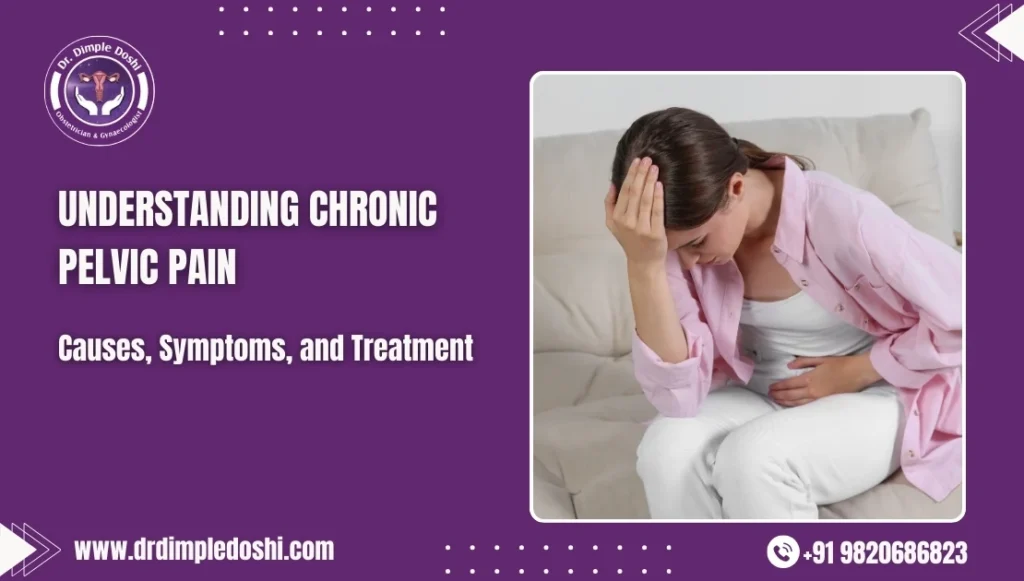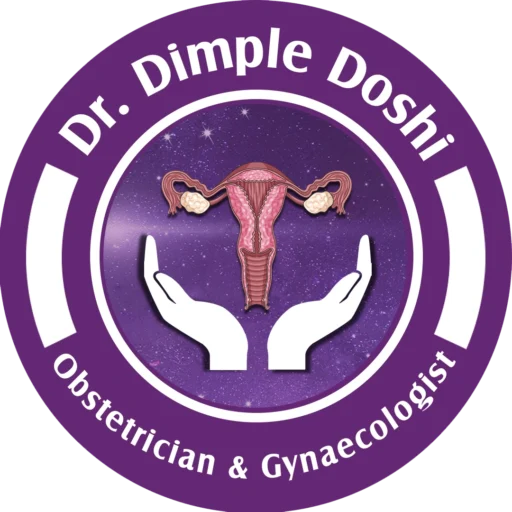Understanding Chronic Pelvic Pain: Causes, Symptoms, and Treatment

Table of Contents
What is Chronic Pelvic Pain?
Chronic Pelvic Pain (CPP) refers to persistent pain in the pelvic region that lasts for six months or longer. The pelvis is located between the abdomen and the legs and houses vital organs such as the bladder and reproductive organs, including the uterus, fallopian tubes, and ovaries.
If you are experiencing this type of pain, consulting a gynecologist is crucial. The Best Gynecologist in Mumbai at Vardaan Hospital, Dr. Dimple Doshi, emphasizes that prevention is better than cure. She provides precise treatment guidelines and preventive measures to help patients manage and understand CPP effectively. Dr. Dimple Doshi is renowned for her expertise in diagnosing and treating chronic pelvic pain with a compassionate approach and state-of-the-art techniques, making her the top choice for patients seeking relief.
Causes of Chronic Pelvic Pain
A. Gynecological Causes
i. Endometriosis: This condition occurs when the endometrial tissue (the lining inside the uterus) grows outside the uterus, leading to pain and discomfort.
ii. Uterine Fibroids: Noncancerous growths within the uterus, known as leiomyomas, can cause dragging discomfort and pelvic pain, especially when the fibroids are large.
iii. Adenomyosis: When endometrial tissue grows within the uterine walls, it causes an enlarged uterus and severe pelvic pain, especially during menstruation.
iv. Pelvic Inflammatory Disease (PID): An infection involving the uterus, fallopian tubes, or ovaries, often caused by sexually transmitted infections or other infections like appendicitis or tuberculosis. Chronic damage from PID can lead to persistent pelvic pain.
v. Pelvic Adhesions: These occur when tissues inside the abdomen stick together due to infections or surgeries, causing chronic pain.
vi. Ovarian cyst and adnexal masses
vii. Pelvic congestion syndrome
viii. Pelvic cancers such as uterine cancer, ovarian cancer, cervical cancer
ix. Pelvic Radiation Therapy for cancer
B. Non-Gynecological Causes
i. GI Causes
- Irritable Bowel Syndrome (IBS)
- Chronic constipation
- Inflammatory bowel diseases
- Diverticulitis
ii. Urological causes
- Painful Bladder Syndrome
- Interstitial cystitis
- Recurrent UTIs
iii. Musculoskeletal causes
- Pelvic floor dysfunction with spasms
- Fibromuscular Conditions
- Herniated lumbar vertebral disk
iv. Neurological disorders
- Nerve entrapment due to endometriosis or fibrosis
- Post-surgical or post- traumatic nerve damage
- Nerve injuries after surgery , childbirth, or accidents
v. Psychological causes
- Chronic stress or depression
- History of trauma or abuse
What to Expect During a Gynecologist Visit
Since various conditions can cause chronic pelvic pain, a thorough evaluation is essential. Your gynecologist will:
- Review your medical history, including pain triggers and worsening factors.
- Conduct a physical examination of the abdomen, back, lower hips, and pelvis.
- Perform an internal pelvic exam.
- Recommend lab tests like complete blood counts, urine analysis, tests for sexually transmitted infections, and a pregnancy test.
- Suggest imaging tests like pelvic ultrasound, CT scan, MRI to detect cysts, fibroids, or adenomyosis or endometriosis
- Conduct laparoscopy, a minimally invasive surgical procedure that allows direct visualization of internal organs to diagnose conditions like endometriosis or PID.
Treatment Options for Chronic Pelvic Pain
i. Pain Management: Using analgesics or routine painkillers to manage symptoms.
ii. Addressing the Underlying Cause: Targeted treatment based on diagnostic findings, such as medication for infections or hormonal therapies for endometriosis.
iii. Medications for Nerve Sensitivity: Antidepressants and anticonvulsants can help manage exaggerated pain responses.
iv. Surgical Interventions: Procedures like laparoscopy for endometriosis, fibroid removal, or hysterectomy for severe cases of PID or adenomyosis.
v. Psychotherapy: Counseling and support from psychologists, psychiatrists, and social workers to help cope with chronic pain and improve quality of life.
Frequently Asked Questions (FAQs)
Q1. Can Chronic Pelvic Pain go away on its own?
Ans. CPP often requires medical intervention to address the root cause and manage symptoms.
Q2. Is Chronic Pelvic Pain (CPP) only related to gynecological conditions?
Ans. No, non-gynecological conditions like IBS and bladder issues can also cause pelvic pain.
Q3. How can I prevent Chronic Pelvic Pain?
Ans. Regular gynecological check-ups, practicing safe sex, and addressing infections promptly can help prevent CPP.
Q4. Can lifestyle changes help with Chronic Pelvic Pain (CPP)?
Ans. Yes, stress management, physical therapy, and dietary adjustments can alleviate symptoms.
Conclusion
Chronic Pelvic Pain can significantly affect your quality of life, but with timely diagnosis and appropriate treatment, it is manageable. Consulting with a skilled gynecologist, like Dr. Dimple Doshi at Vardaan Hospital in Mumbai, ensures you receive comprehensive care tailored to your needs.
If you are experiencing persistent pelvic pain, don’t hesitate to seek professional help and take the first step towards a pain-free life.
ICD-10 Codes for Chronic Pelvic Pain in Women:
Chronic pelvic pain can result from various conditions. Relevant ICD-10 codes for chronic pelvic pain are:
- R10.2: Pelvic and perineal pain (general code for pelvic pain, including chronic pelvic pain)
- N94.1: Chronic pelvic pain (specific code for chronic pelvic pain in women)
- N94.2: Dysmenorrhea (painful menstruation, which may contribute to chronic pelvic pain)
CPT Codes for Diagnosis and Treatment of Chronic Pelvic Pain:
Diagnosis and management may involve several procedures and visits:
- 99201 – 99215: Office or other outpatient visits (for consultations, evaluations, and follow-up care related to chronic pelvic pain)
- 76830: Ultrasound, transvaginal (used to evaluate pelvic organs and identify possible causes of pelvic pain)
- 58100: Endometrial biopsy (if endometrial pathology is suspected)
- 58558: Hysteroscopy, surgical; with sampling (biopsy) of endometrium and/or polypectomy, with or without D&C (for evaluating and treating endometrial conditions)
- 58300: Endometrial biopsy (for obtaining a sample of the endometrial lining if needed for diagnosis)
- 58662: Laparoscopy, surgical; with fulguration or excision of lesions (if surgical intervention is required to address causes of pelvic pain)
- 58660: Laparoscopy, surgical; with lysis of adhesions (if adhesions are contributing to pelvic pain)
